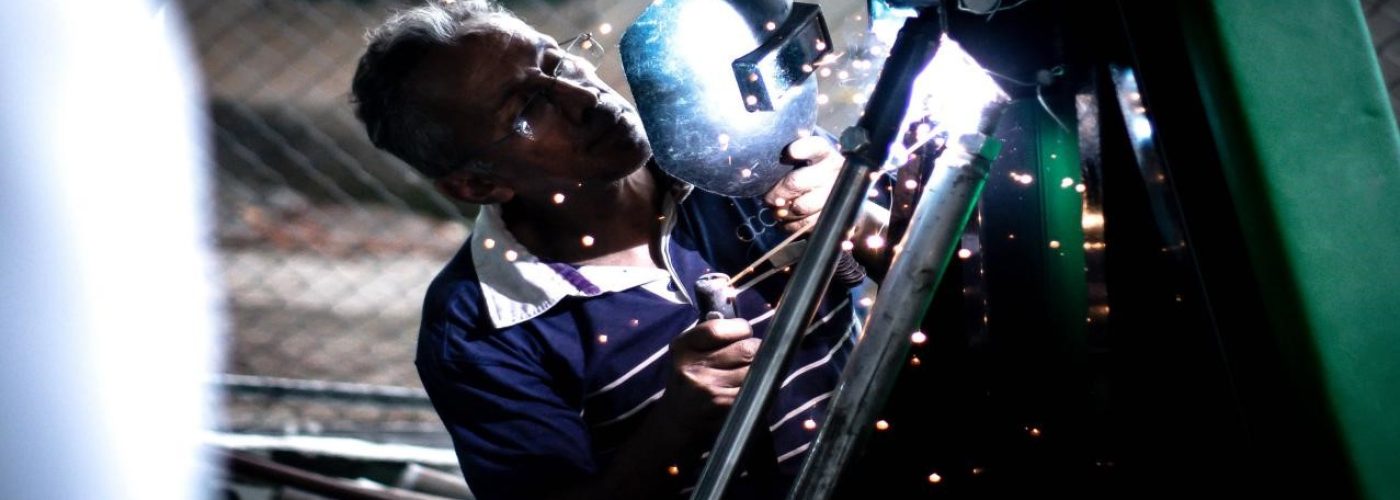MIG stands for (metal inert gas) it is also the same when one says GMAW (Gas Metal Arc welding). It is a process in which an electric arc forms between a consumable wire electrode and the workpiece metal, which heats the workpiece metal, causing them to melt and join. You can read more about this here.
Method of metal transfer does not just include one but there are four primary methods. One is the GMAW or MIG called globular, short-circuiting, pulsed-spray and spray. Each one has its advantages and limitations when used.
MIG, on the other hand, is a technique that is versatile and suitable for both thick and thin sheets. Most welders use this process as it is very flexible working on different sheets. It is widely used in different industries and sectors as it accounts for more than 50% of almost all weld metal that is deposited. Its flexibility, suitability, and deposition rates have more advantage for various mental tasks.
4 Types of Welding Processes

MIG/Metal Inert Gas Welding
This machine works to fill in the spot that joins two metals together. Using this process, the welder doesn’t need to change the electrodes in between their welding tasks. The welder just fills in the joint that is being welded and continue to the next.
There are four main parts of a MIG welding machine. First, the MIG welding power supply that provides the electricity to generate heat. Next, is the wire feed system that usually feeds the wire from the spool to the weld joint. There’s also this handle with a trigger that controls the wire feeder that is feeding the wire on the spool into the weld joint. Lastly, is the shielding gas-guards which are the welder’s weld from the air. MIG works best with sheet metals.
TIG Welding-Tungsten Inert Gas Welding
This is also known as Heliarc welding for retired or older welders as this is a manual welding process that is used before. They differ in the way the arc is generated and how the filler metal is filled in or brought in. This is a tougher process to learn but this is also versatile when a welder is dealing with different materials.
Based on the noted site, the welder needs to use one hand to hold the torch that generates the arc and their other hand to add the filler metal towards the weld joint. This process is effective and will produce high-quality results as it takes time and can be used for smaller welds since it is more precise.
Stick Welding: Shielded Metal Arc Welding
This process includes, of course, an item in stick form. The electrode on this process that uses the metal comes in a stick form. Electricity is used here to melt a rod, filler or stick that can melt both the metal joint and electrode at one time to bring these 2 metal pieces together while filling the joint with the metal filler simultaneously. Usually used for pipelines, auto repairs, steel construction, and most home steelworks since it is low cost.
Flux Cored Arc Welding
This one uses an arc between the consumable electrode and the weld pool with the shielding from the flux that is usually found inside the tubular electrode. An extra shield may or may not be used from a gas supply. This process penetrates well into the base of your works. This is can also be used in indoor and outdoor applications. Mostly for maintenance work, production/fabrication and construction work.
Whatever process is chosen is up to the welder and will be decided depending on what work needs to be done. You can explore websites like http://www.weldingmachinereviews.com to find out more information.
Top 5 Skills of a Welder

First and foremost is attention to detail, welding steelworks and the like needs to have good eyes for their work. To achieve the design and framing of each work, a welder should be skilled in making clean, accurate lines and cuts. Welders should always maintain focus and a good eye towards what they are working on to achieve their goals or final result.
Next is dexterity, not everyone has been gifted with skilled hands. Each person is always good at something but not all the time one has a skillful hand. Good dexterity is being able to coordinate with your fingers and hands as well as one’s hand-eye coordination to finish a single welding task.
Third, physically fit and good physical abilities. Of course, a welder should be physically healthy in performing welding tasks. Good eyesight, not too skinny and not too fast so you can hang on buildings, carry or lift steel (as you know metal pieces are very heavy), move freely and with accuracy.
Quick or fast Learner, welders should always know the do’s and don’t of their job. They also need to keep up with the latest machines and be able to learn how to use them in a very effective and skilled way. They ought to have a sound understanding of their safety and others when performing the said task.
Lastly, stamina and strength. Yes, this is very important as well because welders are always under heat and pressure from their machines as well as the surrounding areas where they usually work. A welder does not work in an office where there is air conditioning, instead, they work while hanging at the side of the building, on the rooftop, outside an establishment, or even hanging down by a bridge.
One can never tell where and what they need to be prepared for when welding. They even have to carry and lift heavy machines or steel materials while they work.





